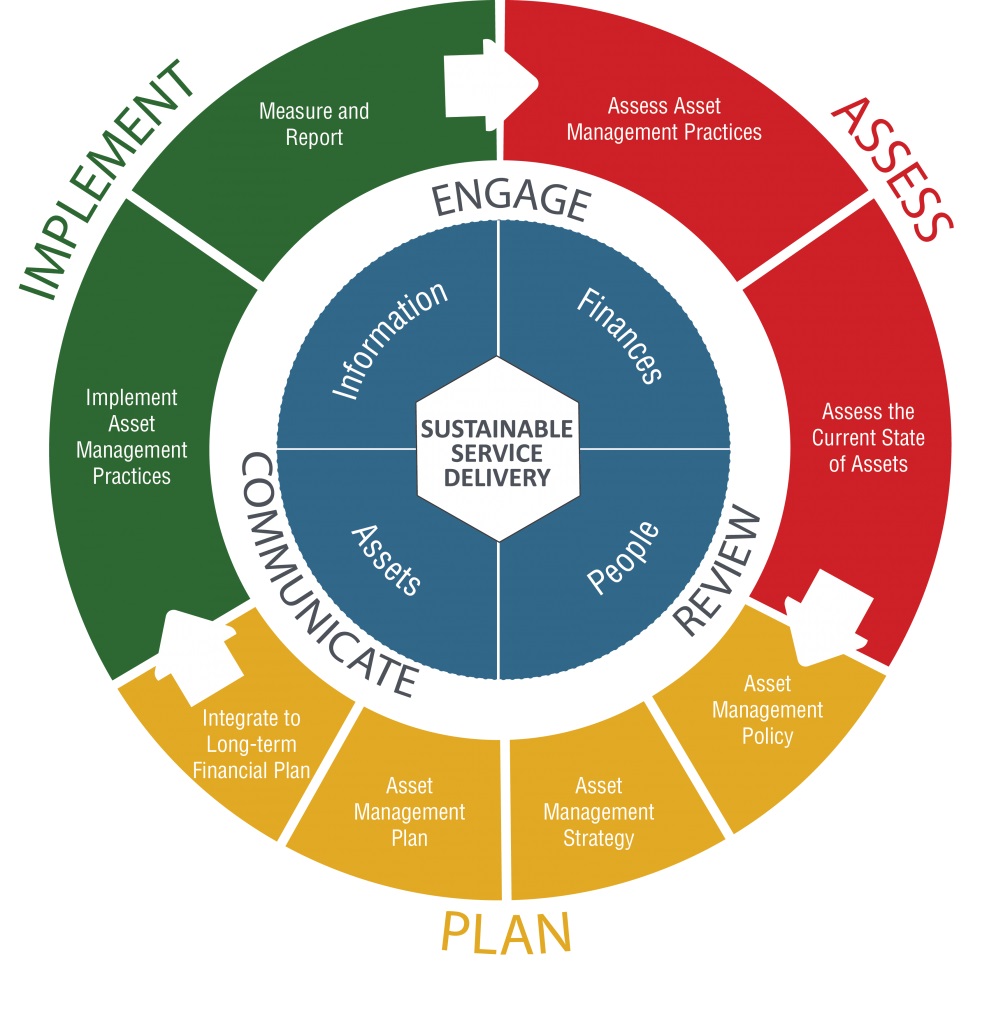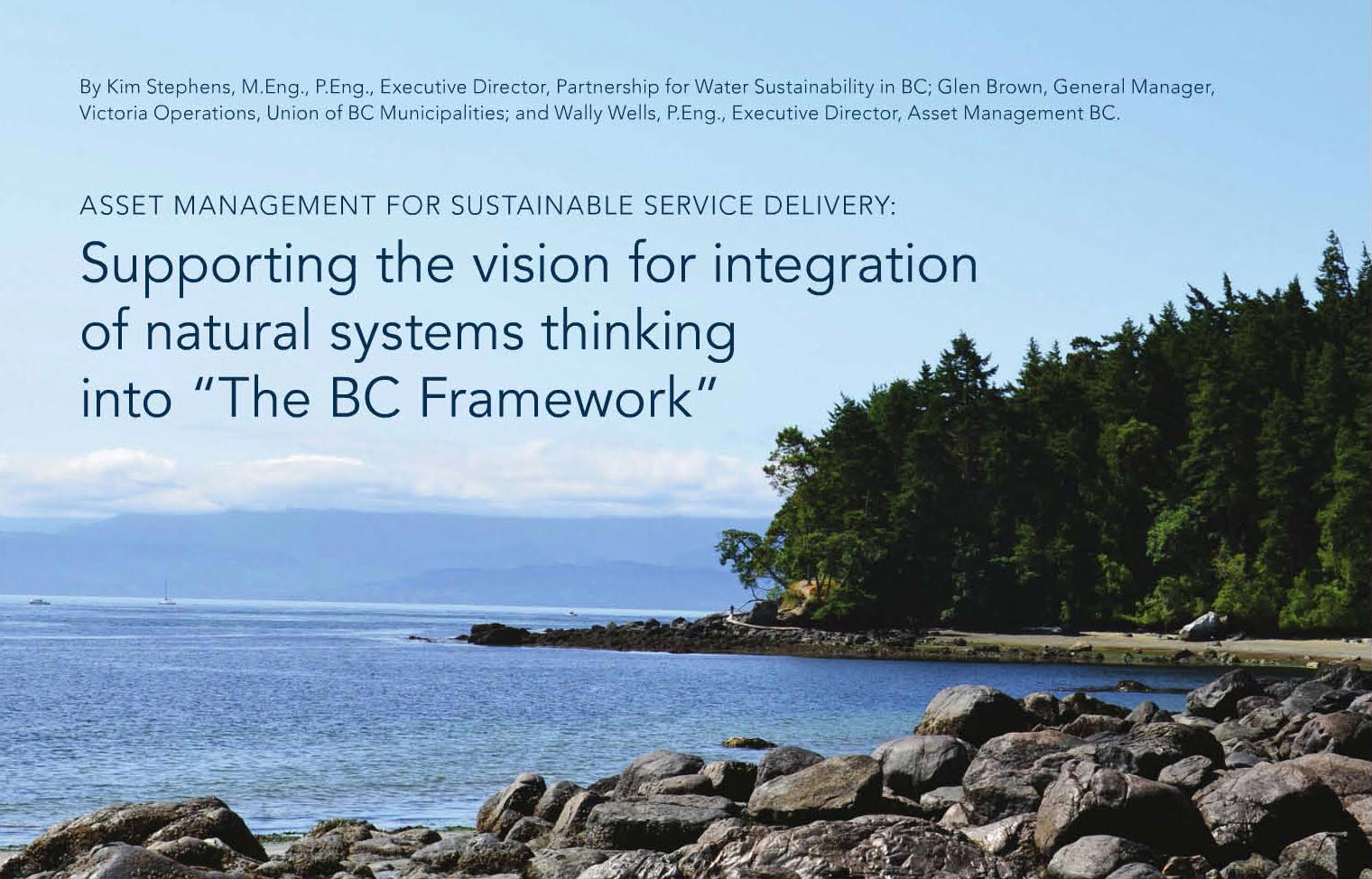GUIDANCE DOCUMENT: “Asset Management for Sustainable Service Delivery: A BC Framework”
Note to Reader:
Released in December 2014, Asset Management for Sustainable Service Delivery: A BC Framework is a game-changer. It makes the link between local government services, the infrastructure that supports the delivery of those services, and the health of watershed systems. The BC Framework was developed by a partnership comprised of the Union of BC Municipalities, Asset Management BC and the Province.
Now, a “long version” expands on the short version by explaining each component of the BC Framework in detail. CLICK HERE to download a copy.
Asset Management and the New Paradigm
The term Sustainable Service Delivery was coined in 2010. It was introduced by the Province of BC to integrate financial accountability, infrastructure sustainability and service delivery.
Sustainable Service Delivery, through Asset Management
 “The word ‘sustainable’ is an adjective, not a noun. Since it is not a ‘person, place or thing’, how could we achieve that which we cannot see, hear, smell, touch, build, buy or steal? Clarity came when I realized the foolishness of attempting to achieve a buzzword. However, if used properly as an adjective, the phrase ‘Sustainable Service Delivery’ makes sense,” says David Allen, Chief Administrative Officer with the City of Courtenay, and the Co-Chair of Asset Management BC.
“The word ‘sustainable’ is an adjective, not a noun. Since it is not a ‘person, place or thing’, how could we achieve that which we cannot see, hear, smell, touch, build, buy or steal? Clarity came when I realized the foolishness of attempting to achieve a buzzword. However, if used properly as an adjective, the phrase ‘Sustainable Service Delivery’ makes sense,” says David Allen, Chief Administrative Officer with the City of Courtenay, and the Co-Chair of Asset Management BC.
“The BC Framework defines Sustainable Service Delivery as a collection of practices that enables continuous delivery of current community services in a responsible manner that does not compromise the ability of future generations to meet their own needs. Sustainable Service Delivery is the singular aim. Sound Asset Management practices prevent in-service failure of assets which consequently cause service delivery interruptions. Therefore, Asset Management is the means to achieve the aim.”
 “While the BC Framework was only launched in early 2015, it has garnered both national and international attention. Other provinces, as well as the Federation of Canadian Municipalities, are integrating the BC Framework into their respective work, and have identified it as a holistic and ‘easy to understand’ resource,” observes Andy Wardell, Asset Management BC Co-Chair and Director of Financial Services at the District of North Vancouver.
“While the BC Framework was only launched in early 2015, it has garnered both national and international attention. Other provinces, as well as the Federation of Canadian Municipalities, are integrating the BC Framework into their respective work, and have identified it as a holistic and ‘easy to understand’ resource,” observes Andy Wardell, Asset Management BC Co-Chair and Director of Financial Services at the District of North Vancouver.
BC Framework for Asset Management Enables Action
 “The BC Framework focuses on desired outcomes, purposely not prescribing specific solutions. It is strategically aligned with asset management requirements under senior government funding programs such as the Gas Tax Program. This provides additional incentive for implementing holistic asset management practices, including the integration of watershed systems thinking and natural capital into asset management,” continues Glen Brown, General Manager (Victoria Operations), Union of BC Municipalities.
“The BC Framework focuses on desired outcomes, purposely not prescribing specific solutions. It is strategically aligned with asset management requirements under senior government funding programs such as the Gas Tax Program. This provides additional incentive for implementing holistic asset management practices, including the integration of watershed systems thinking and natural capital into asset management,” continues Glen Brown, General Manager (Victoria Operations), Union of BC Municipalities.
 “The focus on desired outcomes allows local governments to develop and implement an approach that can be both incremental and measured, tailored to the individual needs and capacity of each local government. The BC Framework recognizes that asset management, and the best practices that support asset management, is scalable to community size and capacity,” adds Wally Wells, Asset Management BC Executive Director.
“The focus on desired outcomes allows local governments to develop and implement an approach that can be both incremental and measured, tailored to the individual needs and capacity of each local government. The BC Framework recognizes that asset management, and the best practices that support asset management, is scalable to community size and capacity,” adds Wally Wells, Asset Management BC Executive Director.
Sustainable Watershed Systems, through Asset Management
“The BC Framework provides a high level overview of what is needed to develop, implement and maintain strong asset management practices for local governments. The BC Framework also points the way to integration of natural systems and climate change thinking into asset management. Resilient cities will be the ones that can absorb water and manage the water cycle as a closed loop,” explains Liam Edwards, Executive Director (for Infrastructure and Finance, Local Government Division) in the Ministry of  Community, Sport and Cultural Development.
Community, Sport and Cultural Development.
“We can view asset management as a continuum. Communities will progress along it incrementally as their understanding grows. By accounting for and integrating the services that nature provides, they can achieve the goal of Sustainable Watershed Systems, through Asset Management.”
To Learn More:
Click on Asset Management for Sustainable Service Delivery: A BC Framework” (long version)
The Summer 2015 issue of Watermark Magazine (published by the BC Water & Waste Association) includes an article that describes how the Partnership for Water Sustainability in BC is championing “asset management for sustainable service delivery”.



